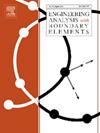A novel automotive side window flow field excitation prediction process based on frequency segmented training method
IF 4.1
2区 工程技术
Q1 ENGINEERING, MULTIDISCIPLINARY
Engineering Analysis with Boundary Elements
Pub Date : 2025-07-04
DOI:10.1016/j.enganabound.2025.106375
引用次数: 0
Abstract
The burden of time and computation of full-vehicle computational fluid dynamics (CFD) simulations hinders research and development (R&D) in automotive aerodynamics. This article introduces a rapid prediction process that is based on neural network modeling to tackle this difficulty. The process establishes a mapping relationship between acoustic excitations and styling geometric parameters to enable quick evaluation of candidate schemes. Furthermore, to overcome the challenges of high complexity in neural network modeling and substantial sample requirements encountered in engineering applications for the process, this research innovatively developed a frequency segmented training strategy based on the varying contributions of geometric parameters to acoustic responses at different frequencies. The strategy involves firstly quantifying the frequency-domain contribution weights of geometric parameters to acoustic excitations using the ridge regression. Subsequently, the entire frequency domain is divided into multiple sub-bands based on the weight distribution, and neural network prediction models are constructed for each sub-band. These models are then integrated to achieve rapid excitation prediction across the complete frequency spectrum. The validation results from two separate samples indicate that the relative errors for acoustic pressure excitation predictions are 1.06 %/0.99 % (with average errors of 0.64 dB/0.56 dB), while those for hydrodynamic pressure predictions are 0.17 %/0.20 % (with average errors of 0.14 dB/0.17 dB). The prediction process facilitates the rapid and precise evaluation of the acoustic excitations of schemes during the initial stage and could direct the screening of candidate schemes, thereby reducing the burden of CFD validation and enhancing the R&D efficiency of automotive aerodynamic design.
一种基于分频训练方法的汽车侧窗流场激励预测方法
整车计算流体动力学(CFD)模拟的时间和计算负担阻碍了汽车空气动力学的研究与开发。本文介绍了一种基于神经网络建模的快速预测过程来解决这一难题。该过程建立了声学激励和造型几何参数之间的映射关系,以便快速评估候选方案。此外,为了克服神经网络建模的高复杂性和工程应用中遇到的大量样本需求的挑战,本研究创新地开发了一种基于几何参数对不同频率声响应的不同贡献的频率分割训练策略。该方法首先利用脊回归方法量化几何参数对声激励的频域贡献权。随后,根据权重分布将整个频域划分为多个子带,并为每个子带构建神经网络预测模型。然后将这些模型集成在一起,以实现跨整个频谱的快速激励预测。两个独立样本的验证结果表明,声压激励预测的相对误差为1.06% / 0.99%(平均误差为0.64 dB/0.56 dB),水动压力预测的相对误差为0.17% / 0.20%(平均误差为0.14 dB/0.17 dB)。预测过程有助于快速、准确地评估方案初始阶段的声激励,指导候选方案的筛选,从而减轻CFD验证的负担,提高汽车气动设计的研发效率。
本文章由计算机程序翻译,如有差异,请以英文原文为准。
求助全文
约1分钟内获得全文
求助全文
来源期刊

Engineering Analysis with Boundary Elements
工程技术-工程:综合
CiteScore
5.50
自引率
18.20%
发文量
368
审稿时长
56 days
期刊介绍:
This journal is specifically dedicated to the dissemination of the latest developments of new engineering analysis techniques using boundary elements and other mesh reduction methods.
Boundary element (BEM) and mesh reduction methods (MRM) are very active areas of research with the techniques being applied to solve increasingly complex problems. The journal stresses the importance of these applications as well as their computational aspects, reliability and robustness.
The main criteria for publication will be the originality of the work being reported, its potential usefulness and applications of the methods to new fields.
In addition to regular issues, the journal publishes a series of special issues dealing with specific areas of current research.
The journal has, for many years, provided a channel of communication between academics and industrial researchers working in mesh reduction methods
Fields Covered:
• Boundary Element Methods (BEM)
• Mesh Reduction Methods (MRM)
• Meshless Methods
• Integral Equations
• Applications of BEM/MRM in Engineering
• Numerical Methods related to BEM/MRM
• Computational Techniques
• Combination of Different Methods
• Advanced Formulations.
 求助内容:
求助内容: 应助结果提醒方式:
应助结果提醒方式:


